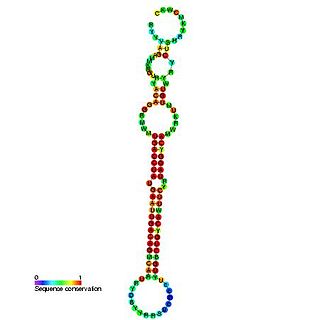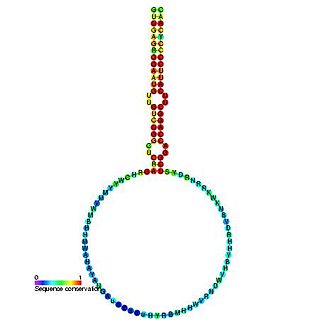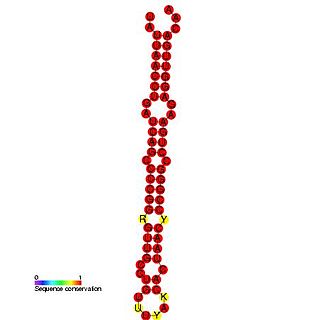Related Research Articles

The miR-103 microRNA precursor, is a short non-coding RNA gene involved in gene regulation. miR-103 and miR-107 have now been predicted or experimentally confirmed in human.

The miR-192 microRNA precursor, is a short non-coding RNA gene involved in gene regulation. miR-192 and miR-215 have now been predicted or experimentally confirmed in mouse and human.

The mir-10 microRNA precursor is a short non-coding RNA gene involved in gene regulation. It is part of an RNA gene family which contains mir-10, mir-51, mir-57, mir-99 and mir-100. mir-10, mir-99 and mir-100 have now been predicted or experimentally confirmed in a wide range of species. miR-51 and miR-57 have currently only been identified in the nematode Caenorhabditis elegans.

The plant mir-166 microRNA precursor is a small non-coding RNA gene. This microRNA (miRNA) has now been predicted or experimentally confirmed in a wide range of plant species. microRNAs are transcribed as ~70 nucleotide precursors and subsequently processed by the Dicer enzyme to give a ~22 nucleotide product. In this case the mature sequence comes from the 3' arm of the precursor, and both Arabidopsis thaliana and rice genomes contain a number of related miRNA precursors which give rise to almost identical mature sequences. The mature products are thought to have regulatory roles through complementarity to messenger RNA.

The miR-1 microRNA precursor is a small micro RNA that regulates its target protein's expression in the cell. microRNAs are transcribed as ~70 nucleotide precursors and subsequently processed by the Dicer enzyme to give products at ~22 nucleotides. In this case the mature sequence comes from the 3' arm of the precursor. The mature products are thought to have regulatory roles through complementarity to mRNA. In humans there are two distinct microRNAs that share an identical mature sequence, and these are called miR-1-1 and miR-1-2.

The mir-2 microRNA family includes the microRNA genes mir-2 and mir-13. Mir-2 is widespread in invertebrates, and it is the largest family of microRNAs in the model species Drosophila melanogaster. MicroRNAs from this family are produced from the 3' arm of the precursor hairpin. Leaman et al. showed that the miR-2 family regulates cell survival by translational repression of proapoptotic factors. Based on computational prediction of targets, a role in neural development and maintenance has been suggested.

mir-395 is a non-coding RNA called a microRNA that was identified in both Arabidopsis thaliana and Oryza sativa computationally and was later experimentally verified. mir-395 is thought to target mRNAs coding for ATP sulphurylases. The mature sequence is excised from the 3' arm of the hairpin.

mir-399 is a microRNA that was identified in both Arabidopsis thaliana and Oryza sativa computationally and was later experimentally verified. mir-399 is thought to target mRNAs coding for a phosphate transporter. The mature sequence is excised from the 3' arm of the hairpin. There are multiple copies of MIR399 in each plant genome, for example A. thaliana contains six microRNA precursors that all give rise to an almost identical mature miR-399 sequence.

The mir-BHRF1-1 microRNA precursor found in Human herpesvirus 4 and Cercopithicine herpesvirus 15. In Epstein–Barr virus, mir-BHRF1-1 is found in the 5' UTR of the BHRF1 gene, which is known to encode a distant Bcl-2 homolog. The mature sequence is excised from the 5' arm of the hairpin. Two other miRNA precursors were found in this reading frame, namely Mir-BHRF1-2 and Mir-BHRF1-3.

The mir-BHRF1-2 microRNA precursor found in human herpesvirus 4, cercopithicine herpesvirus 15 and herpesvirus papio. In Epstein-Barr virus, mir-BHRF1-2 is found in the 3' UTR of the BHRF1 gene, which is known to encode a distant Bcl-2 homolog. The mature sequence is excised from the 3' arm of the hairpin. Two other miRNA precursors were found in this reading frame, namely Mir-BHRF1-1 and Mir-BHRF1-3.

The mir-BHRF1-3 microRNA precursor found in Human herpesvirus 4. In Epstein-Barr virus, mir-BHRF1-3 is found in the 3' UTR of the BHRF1 gene, which is known to encode a distant Bcl-2 homolog. The mature sequence is excised from the 5' arm of the hairpin. Two other miRNA precursors were found in this reading frame, namely Mir-BHRF1-1 and Mir-BHRF1-2.

In molecular biology mir-126 is a short non-coding RNA molecule. MicroRNAs function to regulate the expression levels of other genes by several pre- and post-transcription mechanisms.

In molecular biology mir-143 microRNA is a short RNA molecule. MicroRNAs function to regulate the expression levels of other genes by several mechanisms. mir–143 is highly conserved in vertebrates. mir-143 is thought be involved in cardiac morphogenesis but has also been implicated in cancer.
mir-48 microRNA is a microRNA which is found in nematodes, in which it controls developmental timing. It acts in the heterochronic pathway, where it controls the timing of cell fate decisions in the vulva and hypodermis during larval development.
In molecular biology mir-84 microRNA is a short RNA molecule. MicroRNAs function to regulate the expression levels of other genes by several mechanisms.
In molecular biology mir-5 microRNA is a short RNA molecule. MicroRNAs function to regulate the expression levels of other genes by several mechanisms. mir-5 has been implicated in regulation of VEGF in an experiment where a plasmid containing a cluster of mir-5, mir-10 and mir-7 was shown to down-regulate VEGF by 75%. mir-5 in chicken has been implicated in targeting genes involved in metabolism.
In molecular biology mir-11 microRNA is a short RNA molecule. MicroRNAs function to regulate the expression levels of other genes by several mechanisms. There is an evidence to suggest that miR-11 plays a role in apoptosis.
In molecular biology mir-241 microRNA is a short RNA molecule. MicroRNAs function to regulate the expression levels of other genes by several mechanisms.
In molecular biology mir-275 microRNA is a short RNA molecule. MicroRNAs function to regulate the expression levels of other genes by several mechanisms.

In molecular biology mir-3180 microRNA is a short RNA molecule. MicroRNAs function to regulate the expression levels of other genes by several mechanisms. The mir-10 microRNA precursor is a short non-coding RNA gene that is part of an RNA gene family which contains mir-3180-1, mir-3180-2, mir-3180-3, mir-3180-4 and mir-3180-5. They have now been predicted or experimentally confirmed in a wide range of cancers in humans. mir-3180 has currently only been identified in human Homo sapiens.